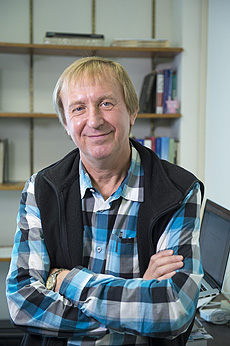One minute with Alexey Burov, beam physicist
 |
Alexey Burov, a beam physicist in the Accelerator Division, enjoys exploring philosophical questions. |
How long have you been working at Fermilab?
I came here in 1997. At that time the project of electron cooling started to be discussed here at Fermilab, and I was brought on as a beam physics expert.
What is a typical day for you like?
Some time ago I developed a theory of beam instabilities at strong space charge, and right now I am working to combine all the ideas inside a single code.
What's the most exciting thing about working here?
In a sense everything is exciting. The entire cycle of scientific research is very exciting. Today, the span of scientific cognition is extremely huge, it's cosmic. We are able to see up to 26 orders of magnitude above our own size. If instead we look toward the small, we face the top quark and Higgs boson, which are 19 orders of magnitude smaller than we are. When you divide these two numbers you get an enormous dimensionless parameter of 1045. This parameter of 45 orders of magnitude universally describes the span of scientific thought. That is already a miracle. It shows our real size, telling of who we are. We are cosmic creatures, cosmic observers.
You recently won fourth prize in a prestigious philosophy contest held by the Foundational Questions Institute. What was your essay about?
The topic of the contest was the mysterious relation of physics and mathematics. I wrote the essay, "Genesis of a Pythagorean Universe," with my oldest son Lev. Our essay is about the source of the laws of nature. In order for these laws to be complex enough to generate life and thinking beings but also simple enough to be discoverable by these beings, the laws must be just right. We concluded that they could not be accidental and could only have been produced by some sort of transcendental mind.
Why did you start the Fermi Society of Philosophy?
Because I like philosophical discussion. And I think there are some people in this laboratory full of intellectuals who cherish philosophy who would be happy to come and share their questions, impressions about philosophical texts and their own ideas.
When did you become interested in philosophy?
My earliest recollection about myself is when I was three years old. It was a rainy day in some industrial region of Siberia, and I thought, "Who am I? What does it mean to be three years old?"
What's the most important philosophical question to you?
This I cannot tell you. Philosophy doesn't have a single set of axioms. It doesn't have axioms at all. If you try to set some axioms, the next question will be, "Why these axioms and not something else?" The philosophical question I'm asking right now usually appears in front of my eyes as the most important.
—Ali Sundermier
Editor's note: The Society of Philosophy meets every other Thursday from noon-1 p.m. in the northwest conference room on the fourth floor of Wilson Hall (the Req Room). It is open to everybody, from curious scientists to contemplative three-year-olds. Mailing list: philosophysociety@fnal.gov
|